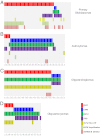TERT promoter mutations occur frequently in gliomas and a subset of tumors derived from cells with low rates of self-renewal
- PMID: 23530248
- PMCID: PMC3625331
- DOI: 10.1073/pnas.1303607110
TERT promoter mutations occur frequently in gliomas and a subset of tumors derived from cells with low rates of self-renewal
Abstract
Malignant cells, like all actively growing cells, must maintain their telomeres, but genetic mechanisms responsible for telomere maintenance in tumors have only recently been discovered. In particular, mutations of the telomere binding proteins alpha thalassemia/mental retardation syndrome X-linked (ATRX) or death-domain associated protein (DAXX) have been shown to underlie a telomere maintenance mechanism not involving telomerase (alternative lengthening of telomeres), and point mutations in the promoter of the telomerase reverse transcriptase (TERT) gene increase telomerase expression and have been shown to occur in melanomas and a small number of other tumors. To further define the tumor types in which this latter mechanism plays a role, we surveyed 1,230 tumors of 60 different types. We found that tumors could be divided into types with low (<15%) and high (≥15%) frequencies of TERT promoter mutations. The nine TERT-high tumor types almost always originated in tissues with relatively low rates of self renewal, including melanomas, liposarcomas, hepatocellular carcinomas, urothelial carcinomas, squamous cell carcinomas of the tongue, medulloblastomas, and subtypes of gliomas (including 83% of primary glioblastoma, the most common brain tumor type). TERT and ATRX mutations were mutually exclusive, suggesting that these two genetic mechanisms confer equivalent selective growth advantages. In addition to their implications for understanding the relationship between telomeres and tumorigenesis, TERT mutations provide a biomarker that may be useful for the early detection of urinary tract and liver tumors and aid in the classification and prognostication of brain tumors.
Conflict of interest statement
The authors declare no conflict of interest.
Figures


References
-
- Aubert G, Lansdorp PM. Telomeres and aging. Physiol Rev. 2008;88(2):557–579. - PubMed
-
- Akiyama M, et al. Cytokines modulate telomerase activity in a human multiple myeloma cell line. Cancer Res. 2002;62(13):3876–3882. - PubMed
-
- Kang SS, Kwon T, Kwon DY, Do SI. Akt protein kinase enhances human telomerase activity through phosphorylation of telomerase reverse transcriptase subunit. J Biol Chem. 1999;274(19):13085–13090. - PubMed
-
- Li H, Zhao L, Yang Z, Funder JW, Liu JP. Telomerase is controlled by protein kinase Calpha in human breast cancer cells. J Biol Chem. 1998;273(50):33436–33442. - PubMed
-
- Kim NW, et al. Specific association of human telomerase activity with immortal cells and cancer. Science. 1994;266(5193):2011–2015. - PubMed
Publication types
MeSH terms
Substances
Grants and funding
- R01 CA075115/CA/NCI NIH HHS/United States
- ES04068/ES/NIEHS NIH HHS/United States
- CA62924/CA/NCI NIH HHS/United States
- N01 CN043309/CA/NCI NIH HHS/United States
- R01 CA121113/CA/NCI NIH HHS/United States
- R01 CA140316/CA/NCI NIH HHS/United States
- CA43460/CA/NCI NIH HHS/United States
- CA057345/CA/NCI NIH HHS/United States
- R01 CA057345/CA/NCI NIH HHS/United States
- CA104106/CA/NCI NIH HHS/United States
- R29 CA075115/CA/NCI NIH HHS/United States
- NCI R37 011898/PHS HHS/United States
- CA075115/CA/NCI NIH HHS/United States
- CA57345/CA/NCI NIH HHS/United States
- R37 CA043460/CA/NCI NIH HHS/United States
- P50 NS020023/NS/NINDS NIH HHS/United States
- CA172380/CA/NCI NIH HHS/United States
- CA121113/CA/NCI NIH HHS/United States
- P50 CA062924/CA/NCI NIH HHS/United States
- R01 CA148826/CA/NCI NIH HHS/United States
- 5R01-CA140316/CA/NCI NIH HHS/United States
- 5P50 CA108785/CA/NCI NIH HHS/United States
- R01 CA172380/CA/NCI NIH HHS/United States
- P50 DE019032/DE/NIDCR NIH HHS/United States
- N01-CN-43309/CN/NCI NIH HHS/United States
- ImNIH/Intramural NIH HHS/United States
- P50DE019032/DE/NIDCR NIH HHS/United States
- R37 CA057345/CA/NCI NIH HHS/United States
- P01 ES004068/ES/NIEHS NIH HHS/United States
- R01 CA129825/CA/NCI NIH HHS/United States
- P01 CA104106/CA/NCI NIH HHS/United States
- CA129825/CA/NCI NIH HHS/United States
LinkOut - more resources
Full Text Sources
Other Literature Sources
Medical
Molecular Biology Databases

